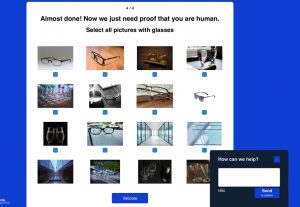
This was an incredibly frustrating exercise.
Having read and watched the week’s assigned content, I thought I would be up to the task and intuitively knew what was to come; despite this, I was amazed at how infuriated the poorly designed user interface made me feel. As well as the chafing reminder of how much time is wasted navigating such things in real-life scenarios and the manipulative techniques embedded within them.
I attempted the game several times during the week and never finished it despite trying my level best. At first, I thought that was deliberate, and the game was designed to be a never-ending loop of madness and folly upon which to reflect… but hats off to Amy Stiff! When I checked her post for this task, lo and behold, she had finished it! Perhaps others have too (I stopped checking after Amy’s post verified my inadequacy :). This led me firmly to the conviction that I must not be human because that was the stage of the game/task I could not cross – selecting pictures to prove my human-ness.
Completing the form was annoying and frustrating as intended, but also an informative, practical exercise in the dark patterns described by Brignull (2011). I could not help but compare this experience to other online interfaces with similar tactics I had been susceptible to in the past, especially those involving financial transactions.
Misleading buttons, incorrect highlights, dubious language, and hard-to-fill (if not impossible) forms giving no indication or feedback regarding how to proceed or what exactly the problem is.
I found Brignull’s article particularly intriguing because of his references to ethical design. I studied architecture and design in the 90s when design ethics were inseparable from design education and taught integrally within it, never considered outside of it. The default (unchallenged) premise was that designers have a moral responsibility to ensure benefit and not cause harm to their end-users. Tristan Harris (featured this week for his TED talk) worked as a design ethicist at Google (Wikipedia, 2022), and Pickering (2021) writes that a design ethicist is “someone who evaluates the moral implications of design decisions and takes responsibility for the effect those decisions have on the world at large.”
There seems to be a shift in where the weight or responsibility of design ethics lies, and I wonder how and in what ways design education and recent developments within it may have contributed to this transformation.
References:
Brignull, H. (2011). Dark patterns: Deception vs. honesty in UI design.Links to an external site. A List Apart, 338.
Pickering, M. (2021, December 29). How to be a design ethicist at any company – UX Collective. Medium. https://uxdesign.cc/how-to-be-a-design-ethicist-at-any-company-f166b2f34ecd
Wikipedia contributors. (2022, December 4). Tristan Harris. Wikipedia. https://en.wikipedia.org/wiki/Tristan_Harris